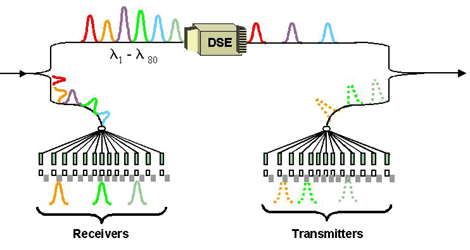Dynamic Gain Equalizers Diversify
Ciena's new optical add/drop mux illustrates how these widgets can be used in optical switches
March 19, 2002

ANAHEIM, Calif. -- OFC 2002 -- Yesterday’s announcement of a new optical add/drop multiplexer by Ciena Corp. (Nasdaq: CIEN) has drawn attention to the potential of dynamic gain equalizers, a key component in Ciena's new box (see Ciena Cleans Up OADM).
Dynamic gain equalizers, or DGEs, are usually pitched as devices for evening out power levels in different channels of DWDM systems. But, as the Ciena announcement demonstrates, another type of DGE may be used to create optical switches. New developments of each type are on show here at the Optical Fiber Communication Conference and Exhibit (OFC).
Vendors demonstrating new DGEs at OFC include Avanex Corp. (Nasdaq: AVNX), Cidra Corp. (Nasdaq: CIDC), DigiLens Inc., JDS Uniphase Inc. (Nasdaq: JDSU; Toronto: JDU), LightConnect Inc., Onetta Inc., Silicon Light Machines, and SpectraSwitch Inc.
DGEs that equalize the power levels of different channels in a DWDM system are being shown by Cidra, Digilens, and LightConnect, and Onetta (see DigiLens Unveils Optical IC, Silicon Light Machines Offers DGE, and Onetta Announces DGEs).
DGEs suitable for use in optical add/drop multiplexers (OADMs) make use of an optical switch architecture called "broadcast and select." In order to do this, the DGE must have very high wavelength resolution, so it can distinguish between neighboring DWDM channels. This enables it to completely block some channels but not others. Put another way, it behaves like a series of filters with very narrow passbands.
The two types of DGE -- those used to even out DWDM power levels and those high-resolution models used for OADMs -- cannot be used interchangeably. Confused? To avoid misunderstanding, some companies have come up with new names for their high-resolution DGE-type devices. JDSU, for example, calls its widget a "wavelength blocker," while LightConnect opts for "dynamic channel equalizer" (see JDSU Parades Picky Part and LightConnect Intros DCE). SpectraSwitch actually calls its device an OADM module, because it incorporates some of the other components needed to achieve full add/drop functionality (see Optical Switching Gets Flexible). To understand how a DGE can be used for optical switching, take a look at the diagram above from Corning Inc. (NYSE: GLW). Light coming in on the left of the picture is divided into two paths by a splitter. The lower path is for the drop channels, which are selected by, for example, tunable filters. In the other path, channels that have already been dropped are prevented from passing through the rest of the switch by blocking them with a DGE (denoted a DSE or dynamic spectrum equalizer in the diagram). Finally, channels are added at the output using another coupler.
To understand how a DGE can be used for optical switching, take a look at the diagram above from Corning Inc. (NYSE: GLW). Light coming in on the left of the picture is divided into two paths by a splitter. The lower path is for the drop channels, which are selected by, for example, tunable filters. In the other path, channels that have already been dropped are prevented from passing through the rest of the switch by blocking them with a DGE (denoted a DSE or dynamic spectrum equalizer in the diagram). Finally, channels are added at the output using another coupler.
One of the benefits of this approach is that it doesn't require the channels to be demultiplexed, switched, and then multiplexed back, as some other approaches do. The overall solution uses fewer components, therefore, which can help keep costs down.
Although it's not immediately obvious, Corning claims that a second reason this architecture is gaining popularity is because it actually has a lower insertion loss than OADMs made using other types of switch fabric such as MEMS. This seems to be as much a reflection of the high losses inherent in other technologies as anything else, and it could change if other switching technologies improve. But, for now, carriers appear to see broadcast-and-select as a safe option and one they are prepared to deploy.
Corning introduced its version of the technology, which it calls the PurePath Dynamic Spectral Equalizer, more than two years ago, making it the incumbent in this space (see Corning Boosts PurePath Production). "We won a prize for this product at OFC 2000," notes Rachel Finley, marketing communications leader with Corning's optical networking devices group.
Corning sells the PurePath product to Marconi PLC (Nasdaq/London: MONI), for the company's PMA-32 reconfigurable OADM, and possibly also to Corvis Corp. (Nasdaq: CORV).
The question for all the newcomers is: Will they be able to overcome Corning's big headstart?
— Pauline Rigby, Senior Editor, Light Reading
http://www.lightreading.com
You May Also Like










